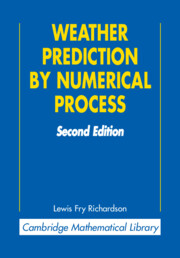Book contents
- Frontmatter
- FOREWORD
- Contents
- PREFACE
- GUIDING SIGNS
- CHAP. I SUMMARY
- CHAP. II INTRODUCTORY EXAMPLE
- CHAP. III THE CHOICE OF COORDINATE DIFFERENCES
- CHAP. IV THE FUNDAMENTAL EQUATIONS
- CHAP. V FINDING THE VERTICAL VELOCITY
- CHAP. VI SPECIAL TREATMENT FOR THE STRATOSPHERE
- CHAP. VII THE ARRANGEMENT OF POINTS AND INSTANTS
- CHAP. VIII REVIEW OF OPERATIONS IN SEQUENCE
- CHAP. IX AN EXAMPLE WORKED ON COMPUTING FORMS
- CHAP. X SMOOTHING THE INITIAL DATA
- CHAP. XI SOME REMAINING PROBLEMS
- CHAP. XII UNITS AND NOTATION
- INDEX OF PERSONS
- INDEX OF SUBSIDIARY SUBJECTS
CHAP. III - THE CHOICE OF COORDINATE DIFFERENCES
Published online by Cambridge University Press: 06 July 2010
- Frontmatter
- FOREWORD
- Contents
- PREFACE
- GUIDING SIGNS
- CHAP. I SUMMARY
- CHAP. II INTRODUCTORY EXAMPLE
- CHAP. III THE CHOICE OF COORDINATE DIFFERENCES
- CHAP. IV THE FUNDAMENTAL EQUATIONS
- CHAP. V FINDING THE VERTICAL VELOCITY
- CHAP. VI SPECIAL TREATMENT FOR THE STRATOSPHERE
- CHAP. VII THE ARRANGEMENT OF POINTS AND INSTANTS
- CHAP. VIII REVIEW OF OPERATIONS IN SEQUENCE
- CHAP. IX AN EXAMPLE WORKED ON COMPUTING FORMS
- CHAP. X SMOOTHING THE INITIAL DATA
- CHAP. XI SOME REMAINING PROBLEMS
- CHAP. XII UNITS AND NOTATION
- INDEX OF PERSONS
- INDEX OF SUBSIDIARY SUBJECTS
Summary
The choice would have to be guided by four considerations: (1) the scale of variation of atmospheric disturbances, (2) the errors due to replacing infinitesimals by finite differences, (3) the accuracy which is necessary in order to satisfy public requirements, (4) the cost, which increases with the number of points in space and time that have to be dealt with.
EXISTING PRACTICE
In general the distance apart of telegraphic stations in the existing distribution is the safest guide to the required scale of proceedings. In a “Map showing the position of the Meteorological Stations, the observations from which are used in the preparation of the daily weather report Jan.—June 1918,” the mean distance between a station and its immediate neighbours appears to be about 130 kilometres, if we confine attention to the British Isles, to which the map principally relates. Or to put it another way: the number of stations marked on the British Isles is 32, and the area of the polygon formed on the map by stretching a string round the outermost stations is about 56 × (100 km)2. So that if the stations were, in imagination, rearranged in rectangular order, there would be enough of them to put one at the centre of each square of 132 kilometres in the side.
From the open sea there are indeed valuable wireless reports of observations on ships (see International Section of Daily Weather Report of Meteor. Office).
- Type
- Chapter
- Information
- Weather Prediction by Numerical Process , pp. 16 - 20Publisher: Cambridge University PressPrint publication year: 2007

